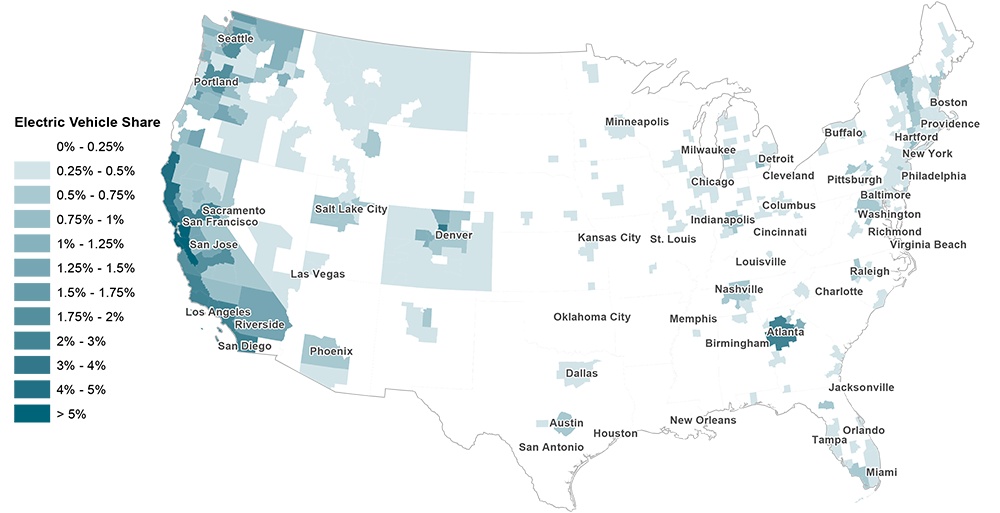Identifying the leading regional electric vehicle markets in the United States
Blog
Mapping U.S. electric vehicle markets and public policy
2016 has been a politically eventful year for electric vehicles in the United States. A few examples serve to sketch a picture of an active policy frontier. Major consumer incentive programs in California and Georgia made news because of unexpected and abrupt changes (see here, here, here, and here). Connecticut launched incentives for both consumers and dealers. Colorado modified its incentive program to offer an immediate tax credit at the point of sale, a change that is likely to be more attractive to prospective consumers. Several electric utilities are deploying public charging infrastructure funded by ratepayers (see here, here, and here). A new electric carsharing program in Indianapolis took off.
What has all of this policy action meant for electric vehicle uptake? In our latest paper, we catalogue the consumer subsidies, charging infrastructure, non-financial incentives, model availability, and outreach and awareness activities in the 50 most populous Metropolitan Statistical Areas (MSAs) and identify links between electric vehicle uptake and the underlying promotion actions.
We identified 33 distinct local actions to promote electric vehicle sales and use. On average, the 50 cities we examined have undertaken a dozen such actions each. While collectively these cities represent approximately 82% of total U.S. electric vehicle sales (approximately 115,000 vehicles in 2015), deployment varies greatly among them. The figure below shows the share of new 2015 plug-in electric light-duty vehicles across the United States. Uptake ranges from less than 0.25% (white) to more than 5% (dark blue).

Electric vehicle share of new 2015 vehicle registrations by metropolitan area. (Source: New vehicle registration data from IHS Automotive)
On average, these 50 cities have three times as many electric vehicle sales as the rest of the U.S. (1% vs. 0.3%). And the map highlights some other interesting details. Electric vehicle uptake is much higher in California and the Pacific Northwest overall than elsewhere: seven cities in that region (San Jose, San Francisco, Los Angeles, San Diego, Sacramento, Seattle, and Portland) stand out as leading electric vehicle hubs, with uptake ranging from over 9% (San Jose) to approximately 2% (Portland). Fiscal incentives clearly seem to matter: Atlanta had a relatively high uptake in 2015, but when Georgia’s statewide tax credit was suspended in mid-2015, monthly sales dropped by 80% to 90%. Colorado also has relatively high uptake, likely due to a very generous income tax credit.
But government policy seems to drive electric vehicle uptake in multiple ways. It’s not just about financial incentives. Diversified action by an array of stakeholders is crucial to expanding the market. Some consumers are motivated by cash on the hood, others by incentives like carpool lane access that shorten commute times and create other conveniences, still others are influenced by public awareness and education campaigns. The cities with the biggest electric vehicle markets tend to offer purchasing incentives, deploy an extensive network of public charging infrastructure, and have a healthy mix of local and utility promotion actions. Furthermore, we’re finding that model availability is statistically linked to electric vehicle uptake. The vast majority (80%) of metropolitan areas had five or fewer electric vehicle models available, whereas the leading markets (San Jose, San Francisco, Los Angeles, San Diego) had about 20 models available.
In addition to the 50 most populous metropolitan areas, we also evaluated potential drivers in a number of mid-size and smaller markets. Regional market leaders like Ann Arbor, Barre, Boulder, and Honolulu – as well as a number of California cities – show similar patterns.
The U.S. electric vehicle market was up nearly 20% in the first half of 2016 compared to a year earlier. And it reached a major milestone in September 2016 with the sale of the 500,000th electric vehicle since 2010. Meanwhile public policy support in the form of direct incentives, investment in charging infrastructure, an array of nonfinancial perks, and numerous educational and awareness promotion actions at the local level continues to build as governments seek to drive growth in the electric vehicle market. Key questions remain, of course. How long will incentives be needed? How much will the next wave of electric vehicles expand the market? What are the electric vehicle hot spots in other key markets such as Europe and China? Stay tuned…
